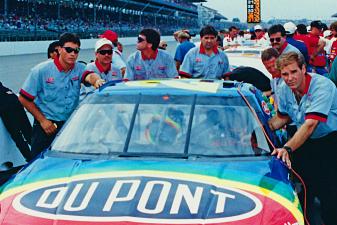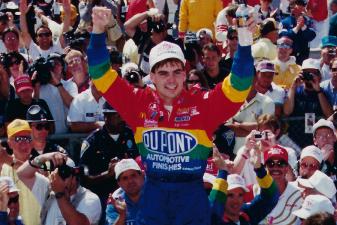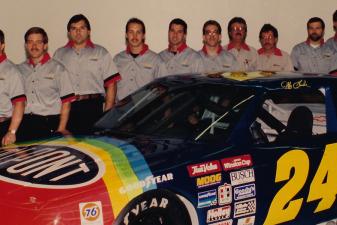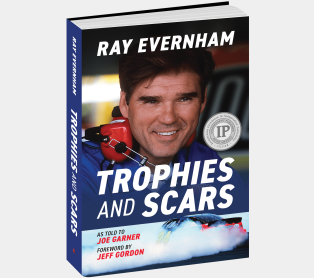Finessing a Tail for the Monte Carlo

The following is an excerpt from NASCAR crew chief Ray Evernham's autobiography, Trophies and Scars. You needn’t be a racing fan to appreciate Evernham’s inspiring journey of tireless persistence, radical determination, steadfast leadership, and fearless reinvention. For as he believes, a life lived to the fullest is packed with trophies—and scars. In this excerpt, read about how a little salesmanship went a long way for getting the tail design just right on the Monte Carlo.
Even with the Coke 600 and Brickyard wins in 1994, we still had a lot to learn. By the end of the season, we’d started to develop the 1995 Monte Carlo. We also started having more fun. For a couple of tests, we painted the car flat black and put a big skull and crossbones on the hood. No number 24 in sight. We also replaced the American flags on the trucks with pirate flags.
Earnhardt’s No. 3 car was black. So was Rusty’s No. 2. So we thought, “The hell with it, we’re just painting this bitch black.” We didn’t want to show up as the “good guys” with the rainbow car.
Hell, we didn’t even shave. We thought we were badasses. We nicknamed our new test car “Blacker,” and it was fast. I loved the Monte Carlo’s overall shape. The nose on the car led nicely up into the windshield. The windshield laid back and the greenhouse narrowed, putting air on the rear spoiler. (The greenhouse of a vehicle is the “glassed” area above the fender line. This comprises the windshield, rear and side windows, and any pillars separating them.) The car was way more aerodynamic than the Lumina.
The only flaw on the car was the narrow tail. It needed to be wider, so we redesigned it. The hurdle was getting NASCAR to sign off on it. This is where Rick Hendrick’s “car salesman” talents came into play.
We had three different tail designs. There was the one already on the stock model. Then we had our preferred tail we’d crafted, which was wider, squarer, and very sharp so it would direct the air to break off the back of the car cleaner, creating even more downforce and reducing drag.
Finally, at Mr. Hendrick’s request, we made an even more extreme looking version. I wondered why he’d want that even though we knew it may be worse performance wise and NASCAR would never approve it.
Rick asked me, “Which one do you want?”
“We want the one we made, it’s the best aerodynamically.”
“Okay, then put the wild one on the car.”
“What? We’re not gonna get that approved.”
He said, “Trust me, Ray. Put that one on for the inspection.”
We did what he said and slapped the more extreme version of the tail on the car. Then in walked Bill France, Mike Helton, and some other NASCAR officials. They all looked the car over. Checked it against the templates. (Back then the car had to fit the street-car parameters. So NASCAR brought in templates copied off of a production Monte Carlo.)
Certain things were negotiable with NASCAR, but there were other things that were not. It was all in the interest of creating equal competition. But the problem was, as bad as they wanted equal competition, all the manufacturers, whether it was Ford, Chevrolet, or Pontiac at that time, were playing whatever games they could with their cars to gain an advantage.

Mr. France got to the tail. “Geez, what the heck is this?”
Rick jumped in. “Look, we really gotta have a little help back there to make this thing competitive. The car’s pretty good otherwise.”
“Well, we can’t approve that tail. We just can’t.”
Knowing this wouldn’t be approved, Rick said, “Look, we gotta have a little help.”
Mr. France asked if we might have another design they could consider as a compromise.
“Well, we’ve got this one.” Rick pointed to the design we preferred. “But it’s not as good. We’d really like to have the one on the car.”
Mr. France quickly glanced at his colleagues, looking for signals.
“All right, you can’t have the one that’s on the car, but you can have our approval of the second design.”
Holy shit. Rick just snookered those guys. That was the car salesman in him.







